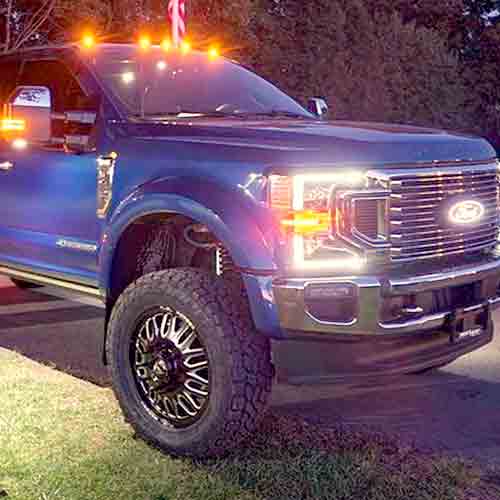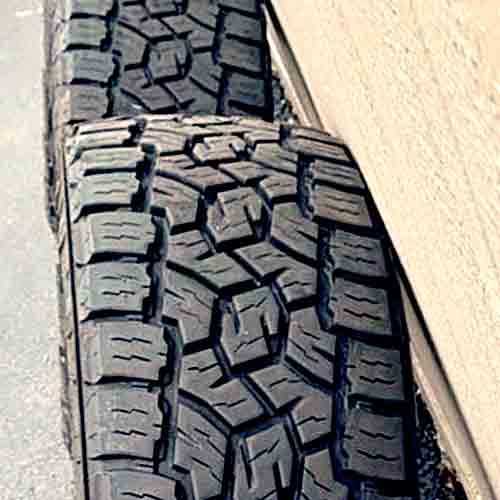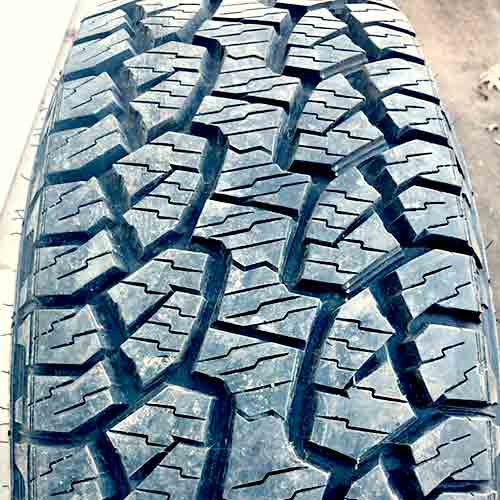Both the Hankook Dynapro ATM and the Toyo AT3 are all-terrain tires perfect tire for enthusiasts looking to get the most out of their trucks and SUVs, as they offer a great balance between off-road traction and highway comfort. Yet, comparing both it can take a lot time to pick one. Let me save you some of that.

Although both tires perform very similarly on dry and wet roads, the Toyo AT3 is still slightly better in a few areas on dry, and it provides a quieter ride along with slower tread wear. Hankook ATM on the other side, does better under wet conditions, and it’s winter performance, and fuel economy are worth considering. Though off-road you’d find Toyo AT3 a better pick overall.
Sizes Facts
The Hankook Dynapro ATM (RF10) provides you with 15 to 20 inches rim diameters with following specs:
- Speed ratings: R, S and T.
- Load ratings: SL, XL, C, D and E.
- Weight range: 32 to 78 lbs.
- Tread depth: 12.5 to 16.5/32″.
- Ratings: 3PMSF and M+S rated.
- Warranty: 50K miles (for non LT sizes).
The Toyo AT3 comes in 15 to 22 inches, having following specs.
- Speed ratings: Q, R, S, T and H.
- Load ratings of C to F.
- Weight range of 30 lbs to 72 lbs.
- Tread depth ranging from 12.7/32″ to 17/32″.
- 65k miles warranty.
Check out detailed review of Toyo AT3: https://tiredriver.com/toyo-open-country-at3-review/
Tread Appearance
Both tires offer a very on/off-road optimized tread. Let’s start with Toyo AT3.

This tire give you S and F shaped lugs in the middle. They have sharp biters facing in all directions and at the same time, equipped with foundations underneath them.
So where the tire provides amazing off-road grip, it does not compromises on it’s on-road stability with those supports.
Same goes for it’s shoulder lugs. They have secondary rubber layers underneath, and connectors in the lateral gaps which give them lateral efficacy on highways.
And to enhance performance on rugged terrains, although these shoulder lugs don’t get to have notches, they still have staggered edges and bulky sidewall lugs, which give plenty of grip.
And that gets improved further, with lowered air pressure, as with that the overall tread’s footprint gets enhanced.
On the other side, the Hankook Dynapro ATM is more aligned towards highway-performance. And looking at its tread it makes sense.

The tire features a 5 rib design, having the middle most rib with Z shaped lugs.
These lugs are wider compared to all other (surrounding), and as they are joined up with each other (lateral grooves don’t split down all the way), you get a good directional on-road grip.
This goes for both dry and wet roads, where on dry, the grip comes with consistent rubber to road meet up, while wet grip comes form numerous interlocking sipes, seen all over the tread (forming similar full depth structure).
The lugs on surrounding (ribs) have wider gaps in between, and so they better connect with the outer circumferential channels providing self cleaning abilities to the tread.
These blocks face the similar looking shoulder lugs with same off set edges and sharp sides, though with having different siping pattern.
Furthermore, since they have reinforced foundations underneath, and join up with each other on sidewalls, they also get credited for most of the lateral stability, the tire brings on highways.
Tire Toughness
To handle rougher tracks off-road although A/T tires are equipped with powerful rubber compositions, they still differ a lot from each other, mainly because of their internal plies make-up, which makes a significant role in determining overall toughness.
Though in case of these two tires, both are very similar, as both of them have 2 high-strength steel belts reinforced with a spirally wrapped nylon cap ply, and all of these plies sit on 2 ply polyester carcass.
Though still if you have to pick one, you can say the Toyo AT3 would provide you with slightly more durable build mainly because of its thicker sidewall lugs. (But this only applies to LT sizes).
Read more: Are A/T tires durable enough?
Off Road Traction
Rugged paths present unique challenges for each terrain type, which is why I analyzed these tires in all of these variations. See below.
On Gravel
This type of terrain includes a lot of dirt particles, and a tire best suited here would have self cleaning grooves and preferably stone ejectors which both of these tires are missing.
Though still, the Toyo AT3 with it’s slightly more design provides better efficacy, moreover, the shoulder lugs having ridges in between basically don’t allow the particles to settle in.
Hankook Dynapro ATM on the other side, is also good enough here, but my main complaint with this tire is under-steering on gravely roads.
On Mud
To handle mud effectively, all-terrain tires require a tire with self-cleaning features and a robust tread pattern that efficiently evacuates mud.
And sicne out of both tires, you get a continuous running central rib on Hankook ATM, and more packed up shoulders without mud scoops (serrated outer edges), you don’t get ample traction abilities here.
Whereas on Toyo Open Country AT3 you are getting more tread depth, better connecting lateral and longitudinal grooves, and thicker outer edges with traction scoops and sidewall lugs throwing the mud backwards, providing forward momentum.
Sandy Dunes
Sand driving is made easier with a tire that has the ability to float better. And it would do so with it’s lighter construction, softer tread compound and wider tread design.
Though in case of these two, we can expel the weigh and tread compound out of the equation, as both tires offer very close similarities there, comparing all sizes.
And that leaves us with the tread design, and with Toyo AT3 featuring larger sidewall lugs (being pasted on a larger bead area), you get to have a better floating abilities with lowered air pressure, as those lugs expand, enhancing tire’s contact patch with the sand.
Rocky Tracks
A tire suitable for driving on rocky roads should have a flexible tread with lugs that bend to provide grip in all directions. And of course, you also need powerful sidewalls both from inside and out.
And comparing both, you get to see a better performance out of Toyo AT3. The tire basically has biters in the middle facing at multiple angles, and that combined with the web of grooves the lugs make, you get a better combination of lateral and longitudinal traction.
Moreover, the tire also features sidewall lugs and staggered outer shoulder edges, and both of these enhance the footprint (with lowered air pressure), providing superior traction and climbing abilities.
Hankook Dynapro ATM on the other side, is missing up with serrated shoulder edges and there aren’t any proper sidewall lugs formation on the sides as well. So the tire lacks a little bit in comparison.
Wet Traction
Improving wet traction involves attention to two important factors: grip and resistance to hydroplaning.
So lets look at both.
Wet Grip
Wet grip is influenced by 2 main factors, which includes how stiff the rubber is, and how are sipes structured. That’s why the Hankook Dynapro ATM with a lot more siping and a softer compound provides better results.
Sipes basically suck water in their slits, and as they do that by contracting/expanding, a flexible tread is really helping.
That’s why Toyo AT3 with it’s stiffer compound and limited siping does not allow for same traction values.
And this can be further explained with hydroplaning as well.
Hydroplaning
Hydroplaning, known also as aquaplaning, occurs when a tire is unable to clear water from its tread promptly, causing floating on the water and decreased traction.
And sicne the Toyo AT3 comes with closed up shoulder lugs with connectors in between, it does not allow water to leave out sideways, and less water going out, means more for there for sipes.
So its also one of the reason why Hankook ATM with its outer wider grooves provides better evacuation.
Dry Traction
In order to accurately assess the dry performance of an all-terrain tire, we must consider traction, steering, and cornering ability. Let’s go over each of these in more detail.
Longitudinal Grip
The longitudinal or directional grip of a tire gets measured with braking distances, as it’s the friction a tire generates while moving straight. And it depends on how much central part of the tread contacts with the surface.
Toyo Open Country AT3 like I explained in the tread section, features lugs with wider gaps surrounding. So it does not make as much contact with the road as the Dynapro ATM, resulting in shorter braking distance.
Sideways Grip
The tire’s handling and lateral traction during cornering is dependent on the ground contact with the outer shoulder lugs.
That’s why both tires show up with similar handling times, as both have the same shoulder surface area offering to connect with the road.
Though still Hankook ATM shows slightly better results and that has to do with steering feedback.
Steering Response
The handling of a vehicle is significantly influenced by how quickly the tire responds to steering inputs.
And out of both tires the reason why Hankook Dynapro ATM is quicker, is because it features a lighter structure, combined with less tread depth.
Both of these factors allow it’s tread lugs to stay firm with the ground, without flexing, as that causing over and under steering and with it slower steering feedback.
Fuel Efficiency
Off-road tires with aggressive designs are not so great in terms of fuel economy, but evaluating their performance for long-term benefits is still important, as even a little bit of a difference matters.
That’s why although there’s only a tiny margin, the Toyo AT3 is still a better tire to have in terms of fuel efficiency, as you get less rolling resistance with it.
It basically offers a more balanced tread to void ratio, so even though it makes a heavier construction, the weight gets more evenly distributed across the blocks when the tire meets the road.
In other words, each lugs carries a smaller portion of the weight, and so they don’t rub with the surface they are on, with that much force, whereas the opposite happens on Hankook Dynapro ATM. (Though generally all-terrain tires don’t give out good gas mileage).
Tread Mileage
Tread mileage depends on 3 things, rolling resistance, tread depth and composition.
And looking at both tires, the tread depth and composition gets eliminated, as both tires have very similar structures, across all their sizes.
And the leftover lower rolling resistance tells us why Toyo AT3 lasts longer, and comes with 15k more more miles in warranty.
Also Read:
How to Increase tread life?: https://tiredriver.com/how-to-increase-tread-life-on-tires/
Do A/T tires wear faster?: https://tiredriver.com/do-all-terrain-tires-wear-faster/
Winter Performance
The tire’s success in winter weather depends on its ability to provide stability during stops, maintain control during turns, and effectively accelerate on shallow and deep snow (and ice too).
And although both tires have 3 peak mountain snowflake and M+S ratings, the Toyo AT3 still provides better gripping in comparison.
That’s because the tire features smaller blocks with notches facing in all directions, and these effectively grab in the snow particles and make snow to snow contact with them.
Hankook Dynapro ATM on the other hand, does not provide ample biters, especially on the middle most rib. Moreover, with missing staggered shoulders, and sidewall lugs, its not able to provide efficient snow scooping when it comes to deeper terrains as well.
Also Read:
Are A/T tires good in Snow: https://tiredriver.com/are-all-terrain-tires-good-in-snow/
Summarizing
Although both tires provide you with very similar dry and wet grip on roads, with very close margin, the overall dry traction is seen better on Toyo AT3, while the wet, on Dynapro ATM.
The Toyo AT3 basically features a harder compound, that’s why it comfort, fuel economy and sand traction gets compromised. Though it also helps the tire with tread wear now doubt.
And although both tires aren’t so great with rocks or mud, Toyo still provides better efficacy there too.